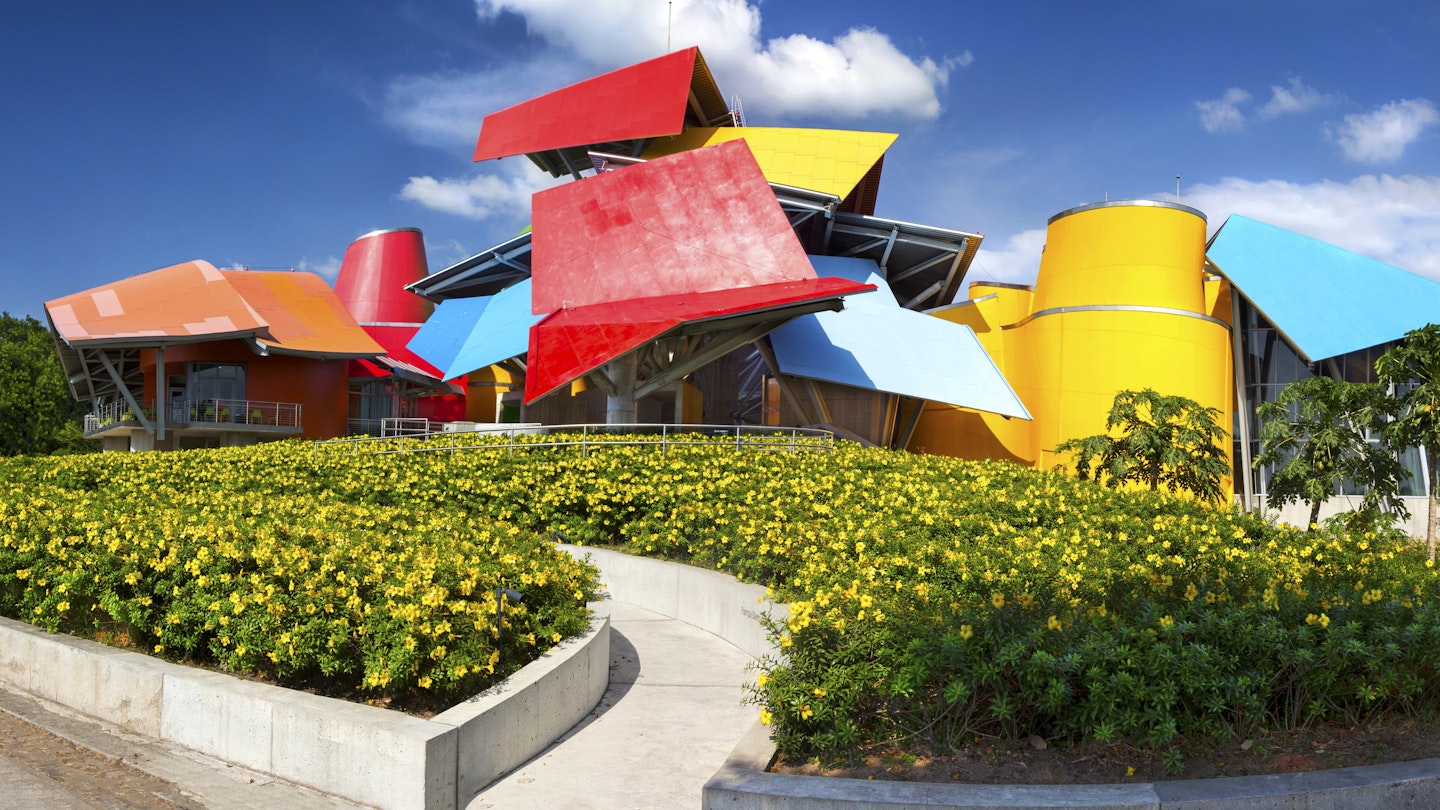Panama City’s museums offer an intriguing exploration of the country’s natural and social history, making them valuable for those seeking a deeper understanding of this Central American destination.
Museo de Arte Contemporáneo: Best for Contemporary Art
Panama’s only art museum, the Museo de Arte Contemporáneo de Panamá (popularly known as MAC Panamá), boasts the largest collection of Panamanian art in the world. Established as a non-profit NGO in 1962, the museum secured its permanent location in 1983 after renovating the old Masonic Temple in the Canal Zone settlement of Ancón.
Today, the museum showcases approximately 700 contemporary works by artists throughout Latin America, including mediums such as oil paintings, drawings, lithographs, photographs, sculptures, and ceramics.
Moreover, it regularly hosts permanent and temporary exhibitions and provides opportunities for art students to participate in workshops and lectures (in Spanish). Its graphics laboratory is nurturing new and emerging artists in traditional printmaking, while its library features catalogs and volumes on Panamanian art.
BioMuseo: Best for Ecological History
The isthmus of Panama emerged from the ocean approximately 15 million years ago, transitioning from a series of volcanic islands to a significant land bridge connecting the American continents.
Designed by the acclaimed architect Frank Gehry, the BioMuseo explores the ecological significance of these events. Nestled on the canal’s edge along the Amador Causeway, this museum took 15 years to construct and opened in 2014, featuring a roof design that symbolizes the natural world’s diversity.
The grounds also include landscaped botanical gardens with trails and ponds, offering a chance to observe a variety of bird and butterfly species.
This unique project employs artistic media to delve into themes of biodiversity, ecological interconnectedness, evolution, extinction, and geological history. The exhibitions span eight galleries developed in partnership with the Smithsonian Tropical Research Institute and the University of Panama.
Weil Art Gallery and Galeria Arteconsult: Top Art Galleries in Panama City
Beyond MAC Panamá, many chic galleries and stores reflect the city’s burgeoning art scene. Some are located in the revitalized historic quarter of Casco Viejo, while others are hidden in the bustling banking district. Careful planning is advisable, along with checking opening times before visiting.
In the Bella Vista district, Weil Art Gallery stands out as a vibrant contemporary space run by Brazilian art dealer Carlos Weil. Meanwhile, Galeria Arteconsult, located in Punta Paitilla, has been a leader in contemporary Latin American art for over thirty years.
Additionally, cultural spots like Karavan in Casco Viejo focus on quality indigenous art and crafts, while NG Gallery in Marbella showcases intriguing artists from Cuba. Tamarindo in El Cangrejo offers a stunning selection of contemporary pieces by local artists, and the Marion Gallery owned by the Cruz family in San Francisco highlights deep roots in Panama’s art community.
Afro-Antillean Museum of Panama: Best for Social History
Housed in a historic chapel built by Barbadian missionaries in 1910, the Afro-Antillean Museum of Panama provides insights into the history of Antillean immigrants who settled in Panama during the 19th and 20th centuries.
Over the years, tens of thousands migrated from the Caribbean to work in various sectors, notably on the railroad and the canal. However, while opportunities existed, the reality of working on the mainland was often brutal.
The museum honors the contributions and sacrifices of Afro-Antilleans throughout Panama’s history, featuring exhibits that include artifacts, historical photographs, and mock-ups of the living conditions experienced by immigrant workers.
Museo del Canal Interoceánico: Best for Canal History
The Museo del Canal Interoceánico de Panamá is strategically located overlooking the gardens of Plaza de la Independencia, where Panama declared independence from Colombia in 1903.
This museum illustrates the historical evolution of Panama as a vital transit point, tracing back to the mule trains of the Spanish Empire. It guides visitors through the events that made the isthmus integral to world trade, including the construction of the Panama Railroad and various efforts to build the canal.
Importantly, the museum provides English audio guides, accommodating the diverse audience interested in learning about this significant aspect of Panama’s history.
Museo de la Mola: Best for Guna Art
The small yet vibrant Museo de la Mola offers insights into the art and symbolism of the mola, a reverse appliqué textile crafted by Guna women. Traditional mola designs include intricate geometric shapes and abstract patterns, steeped in cultural significance.
Modern mola creations may depict various themes, including wildlife and mythology. These textiles serve as decorative items, often adorning blouses or being transformed into wall art.
Tips for Buying Molas
Given their lightweight nature and durability, molas make excellent souvenirs. They feature meticulous craftsmanship, with layers of fabric creating intricate designs. When purchasing, it’s essential to check for quality, ensuring that the mola’s construction is intact and not damaged by sunlight.
Typical prices range from USD $20 to $50 for basic molas, with more intricate pieces commanding higher prices. To appreciate the artistry fully, visiting the Museo de la Mola prior to making a purchase is recommended, as local Guna vendors are prevalent throughout the city.




